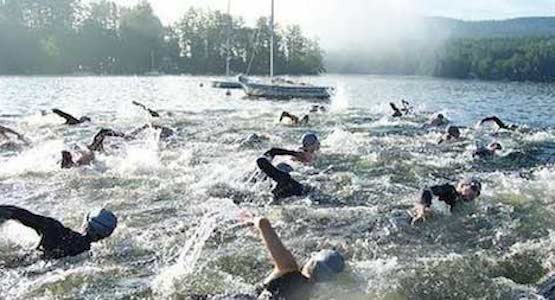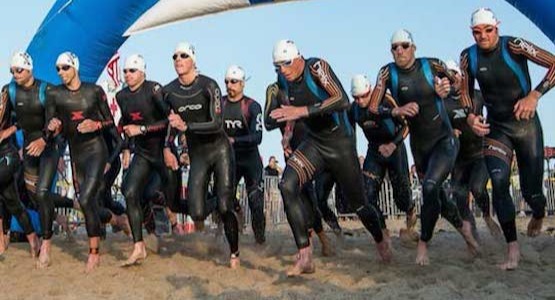WETSUITS
Triathlete tips
by Brett Nichols, pro triathlete
Brett Nichols has been working at Landry's Boston store. During his time with us, he earned his elite triathlon license and has competed as a professional ever since. In these Landry's Triathlete Tips, Brett shares what he has learned.
"You may be racing in what is technically summer, but the ocean and lakes of New England have their own calendar."
When the going gets wet…
Biking is just one aspect of the triathlon, and during the swimming leg cyclists can seem like a two-wheeled fish out of water. So if you’re considering making an investment into tri gear beyond the essentials (a bike, goggles, and running shoes), a wetsuit should be at the top of your list as your next piece of equipment. Triathlon-specific wetsuits are a fantastic tool for training and racing. Here’s why:

Baby, it’s cold outside!
Regardless of the air temperature, you won’t have any luck finding a body of water in New England that’s above 70 degrees until the end of June at the earliest. And 60-something degree water feels painfully cold. Investing in a wetsuit, especially early in the race season, will help to ensure you don’t panic when you hit the cold water surrounded by hundreds of swinging arms and kicking legs.
Landry’s offers triathlon wetsuit rentals for the occasional weekend warrior just starting out. However, owning your own wetsuit will enable you to do open water swim workouts earlier in the season, which will help you swim faster than your pool-training competitors. Plus, having your own suit allows you to get familiar with your body’s movements while wrapped in a rubber suit. You don’t want the first time you put on a wetsuit to be 5:30am on race day…
Leveling the playing field
Wetsuits offer a serious advantage in open-water swimming by providing better buoyancy. This buoyancy brings the body higher out the water, providing better water displacement and lower surface friction, resulting in a swim-skin that cuts through the water. Depending on the athlete, a wetsuit can bring anywhere from a one to five minute benefit in a one-mile swim. (This is especially noticeable in weaker swimmers.) This is why most of your competitors will race in a wetsuit.
For racing, wetsuits are allowed whenever the water is 78 degrees or colder, which is the case for most races in New England. I still remember one of my first races 10 years ago, the Timberman Half-Ironman in NH, when I was one of less than 10 people in the entire field of 800 without a wetsuit. I was swimming at a disadvantage to 790 of my competitors. Before my next race, I bought a wetsuit.

Choosing your wetsuit
Here at Landry’s, we feature Blueseventy wetsuits. I personally train and race in a Blueseventy suit because Blueseventy is a swim company. Blueseventy also designs wetsuits for women with their Femme Fit, with specific forms in critical fit areas like the bust, torso, hips, wrists, and ankles. The company is devoted to understanding the mechanics of the body in the water, and they design wetsuits that make every swimmer faster.
Blueseventy has two lines of wetsuits, neutral and positive, which change the body’s center of buoyancy in the water. Less experienced swimmers tend to drag their hips and legs lower in the water than their torsos. The Fusion, a positive buoyancy suit, features thicker neoprene that levels a swimmer’s upper and lower body and raises their entire body to a higher position in the water.
For their neutral buoyancy suits, the Reaction and Helix, Blueseventy caters to experienced swimmers who are already balanced in the water and raises their entire body position with minimal restriction to their movement. It’s subtle, but a few millimeters of neoprene can make all the difference in the world for efficiency and comfort!
Sizing up your wetsuit
Choosing the correctly sized wetsuit can be challenging — especially if you've never tried one on. If you plan on fitting into a wetsuit for the first time this season, let me assure you of a few things:
- It will be a very hot ordeal. Yes, I'm sure you'll look great, but I'm talking about the fact that you will sweat during this changing exercise.
- Your movement will be restricted. It will feel like the motion of your arms and legs is bound by a rubber band, because... well... it basically is. A trick to minimizing this feeling is to hike the suit up as much as possible. The “undercarriage” of the suit should meet with yours, and the armpits of the suit should meet with yours. I achieve this by gently (to avoid cutting the rubber with fingernails) tugging up from the hips and from the tops of your arms over your shoulders. But even so, it will still feel like you're wrapped in rubber bands.
- It will feel a little laborious to breathe. I'll say it one more time — you're wrapped in rubber bands, and you should feel some compression around your chest. That said, you should be able to breath and be comfortable with the amount of restriction you're experiencing. If not, it's better to have a slightly looser suit than to suffocate yourself. :-)
Don’t worry, these challenges don’t mean the suit you are trying on is too small. Your suit is properly sized if you can zip it and you see no wrinkles when you stand up with your arms at your side. Keep in mind that wetsuits are meant to fit when they are WET! And you’ll get a small layer of water between you and the suit, which makes it feel a little looser once you start to move around.
Try before you buy: For athletes new to wetsuits, I recommend renting one and going swimming with a friend to try it out before racing in one. Landry's has a great program that rolls the cost of your rental in to the price of your new suit, so it's no added expense to give one a test ride before making the purchase. We want you to be comfortable in your second skin.
Getting into wetsuits
Getting in your skin-tight rubber suit can be tricky, so here’s a low tech pro-tip: Put plastic grocery bags on your feet before stepping into your suit to help your legs slide through more easily. The same trick works with the arms, but I’ve never had enough trouble getting the sleeves on to warrant that silly factor of walking around like a bag-monster.
Taking off your wetsuit in the transition
Getting out of your wetsuit quickly in the transition can also be tricky! The top of the suit slides off and turns inside-out fairly easily as you’re running from the water, so when you get to your bike, pull your wetsuit down to your knees, and then take a few marching steps in place to pull your feet out. You may find that you usually have to use your hands to pull the bottom of the suit around your ankles and heels. To avoid this, you can also carefully cut your wetsuit up to about 2 inches below the widest part of your calves. This will widen the hole, and make it easier for your foot to step out of the wetsuit quickly in transition.
Taking care of your wetsuit
- After every use, rinse the suit with tap water when you get home. I usually take my wetsuit in the shower with me after a workout or race. I rinse it inside and out, and hang it on the shower rod.
- Hang the wetsuit to dry inside-out first. Then turn it right-side-in, put it on a hanger, and wipe off any remaining water.
- After it's all dry, hang your wetsuit in the coat closet — or somewhere you don’t mind smelling like rubber.
A few more tips on wetsuits
- Buy some Body Glide with your wetsuit and apply it generously around your neck, shoulders, and ankles. Without some sort of lubricant, your skin-tight rubber suit will chafe — especially in salt water. Be sure NOT to use petroleum-based lubricants, so NO Vaseline.
- DON'T use your wetsuit in chlorinated water (e.g., swimming pools), because the chlorine will damage the material and decrease your wetsuit's longevity.
I hope these tips help keep you fast and afloat out there. The swim can be the most challenging leg for many cyclists, so be sure to take all the advantages you can get!
Everything you need to know about triathlons
Learn more from Landry's about the sport of triathlon.
